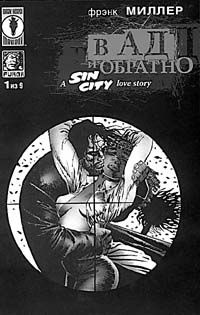Most our people have a rather vague idea about comics, associating them with funny pictures in children’s magazines, showing heroes of animated cartoons and their simple dialogues. In actuality, this synthetic genre was born more than a hundred years ago and it occupies a major place in the culture of numerous Western countries. Few know that this cocktail of literary writing and illustrations, based on the principle of movie sequence, has far greater devotees among teens and adults than children. In Ukraine, the first comics meant not for children appeared only this year. So far these are translations from US thrillers and horror stories Sin City, Terminator, and Zombie World. Hopefully, comic strips with Ukrainian characters and stories will shortly appear and win international acclaim. The Day discussed the subject with Serhiy USENKO, director of the pioneer company Compasspublishing.
The Day: How is one to understand comics?
S. U.: They constitute a unique genre on the threshold of literature and pictorial art. It’s hard to say what comes first. On the other hand, one can describe them as pictures with captions; on the other, they are illustrated stories. Actually, both the pictures and captions are important in producing the overall effect.
The Day: What is the status of comics in Ukraine?
S. U.: There’s nothing to talk about. Until now we had comics for children, mostly supplied by Russia. Our company offers a fundamentally new product, comics meant for customers aged 16-35. We have a contract with the US company, Dark Horse Comics (there are about five large companies holding copyrights of most available comics), and a license agreement allowing the publication of comics series in the CIS. In Russia, the first such comics also appeared recently, in November. We decided that, since our market doesn’t have this kind of good, we should supply it. And it is really an interesting commodity. It’s a whole culture, I mean reading and collecting comics, which is quite developed across the world. Collecting comics is important; they are mostly issued as series and it’s very interesting to collect all such series and reread them now and then, trade them with friends, and so on.
The Day: From what I know, comics appeared in the West a very long time ago. Why did we get them only recently?
S. U.: That’s right. Comics have been read in the United States for the past hundred years. And mind you, they first appeared not being meant for children but for adults. The first comic strip was carried by the New York City Sunday World in 1895. It was a series of pictures with captions. Teen comics were not encouraged by the Soviets, considered an element of “decaying” American culture. Yet even now, with all ideological barriers eliminated in the way, comics are not exactly popular. Maybe this is because there is the tangible obstacle of not having the right kind of printing facilities. Modern technologies used in the production of comic strips appeared in Ukraine very recently and there are just three properly equipped companies.
The Day: How are comics made?
S. U.: As a rule, it’s teamwork, including the author of the story, the cartoonist creating the characters, using India ink, the colorist that makes the pictures come to life, and the letterer doing the captions. By the way, we had a very hard time finding a letterer in Kyiv, so we developed computer Cyrillic fonts matching English handwritten captions.
The Day: Do you think that comics will be in demand in Ukraine?
S. U.: Before starting on the project, we commissioned a Ukrainian company to do market research, and their findings turned out quite promising. Considering that the comics culture is underdeveloped in Ukraine, we decided to issue the first issues of each of the series – Sin City, Terminator, and Zombie World – with a print run of 15,000 copies, although the market allows a much larger circulation. We’ll be able to size it up in a couple of months.
The Day: Are you planning Ukrainian comic strips, written by Ukrainian authors?
S. U.: Sure. We plan a comics studio, but this will take time. For the time being we want to probe the market with US products popular all over the world. But we’ll certainly try to commission Ukrainian script writers and cartoonists, so we can have our own Ukrainian characters.
The Day: What about those Ukrainian characters?
S. U.: Hard to say at the moment. From what I know, the Russian publishers plan comic strips starring a woman detective, based on the Kamenskaya books. A comics hero doesn’t have to originate from an animated cartoon or a movie (like Mickey Mouse or the Terminator). Quite often the reverse is true, as in the case with Batman, Dick Tracy, and many other characters appearing in TV series but originating from comic strips. Some of these trends will hold true for the Ukrainian characters. There is uniform ideology for all comics: good fighting and getting the better of evil, and it’s up to the authors and national cultural specifics to select shapes and appearances. I’m sure that we have plenty of interesting material in Ukraine, along with people capable of producing good stories.
The Day: Could you by any chance be planning political comics?
S. U.: We’d like to keep out of politics. Our company is entertainment-oriented, allowing people to relax, taking them away from their everyday worries. This is very important for everybody, imagining oneself a superhero, venting one’s fantasies, fighting and overcoming evil. I think that’s why people buy and read comics.







